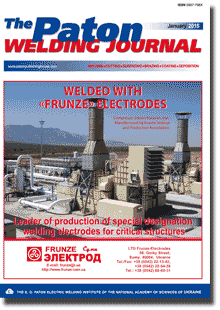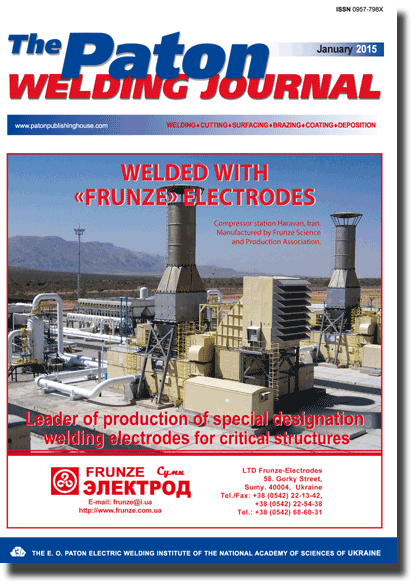| 2015 №01 (05) |
DOI of Article 10.15407/tpwj2015.01.06 |
2015 №01 (07) |

The Paton Welding Journal, 2015, #1, 35-42 pages
APPLICATION OF WELDED STUDS FOR FASTENING OF RAILWAY BRIDGE DECK
V.V. Knysh1, S.A. Solovej1, A.A. Grishanov1, G.O. Linnik2 And M.G. Malgin3
1E.O. Paton Electric Welding Institute, NASU. 11 Bozhenko Str., 03680, Kiev, Ukraine. E-mail: office@paton.kiev.ua
2Ukrzaliznytsya. 5 Tverskaya Str., 03680, Kiev, Ukraine. E-mail: cpi@lotus.uz.gov.ua
3MIDAS Information Technology Co., Seul, Korea. E-mail: malgin@midasit.com
Abstract
Proposed is a new structure of fastening of slabs of ballast-free bridge deck to T-girders of railway bridges, which provides for change of thread studs to welded ones. Arc-contact welding allows for stud positioning directly over vertical wall of T-girder that does not result to angular deformation of girder upper flange typical in application of thread studs. Aim of present work was evaluation of possibility of application of welded studs for fastening of slabs of ballast-free bridge deck in construction and repair of railway bridges. For that, fatigue tests of welded joints of stud to upper flange of girder from the most wide-spread steels St3sp (killed) and 09G2S were carried out at different ranges of loading, which are realized in stud preliminary tightened with 6 tf force during rolling stock movement. It is determined that cyclic life of such joints exceeds 5x106 cycles of stress alternation at loading range DP Г 3 tf. Numerical simulation showed that application of oak board and rubber band as spacing layer between slab of ballast-free bridge deck provides for cyclic life of welded stud not less than 5x106 cycles of stress alternation, since loading range exceeds DP = 3 tf. However, application of fast hardening nonshrinking mixtures (cast-in-place concrete) as spacing layer allows reducing range of loading to DP = 1 tf, that guarantees welded stud life not less than 5x106 cycles of stress alternation. 13 Ref., 2 Tables, 16 Figures.
Keywords: welded joint, welded stud, slab of balast-free bridge deck, fatigue resistance, fatigue test
Received: 20.11.14
Published: 28.02.15
References
1. Linnik, G.O., Zakora, O.L., Marochka, V.V. (2010) Experimental investigations of carrying capacity of longitudinal beams depending on type of bridge deck. In: Theory and practice of building industry, 193-195. Lviv: NULP.
2. Linnik, G.O. (2010) Studies of local deformations of concrete spacing layer using bridge deck on ballast-free bridge slabs (BFBD). Ibid., 293-296.
3. (2009) Procedural guidelines on spacing layer arrangement of ballast-free bridge deck on concrete slabs of metal spans of railway bridges in different service conditions. St.-Petersburg: NIIM.
4. R 773/11:2004: Polymer composite cushion under slabs of ballast-free bridge deck. Organizing cooperation of the railways. Moscow.
5. (1990) Guidelines on inspection and reinforcement of in-service welded spans. Moscow: NII LIIZHTa.
6. RD 50-694-90: Procedural guidelines. Reliability in technique. Probabilistic method of fatigue design of welded structures. Moscow.
7. DBN V.2.3-26:2010: Bridges and pipes. Steel structures. Design rules. Kyiv: Minregionbud Ukrainy.
8. DSTU-N B EN 1993-1-9:2012: Eurocode 3: Design of steel structures. Pts1-9: Endurance (EN 1993-1-9:2005, IDT). Kyiv: Minregionbud Ukrainy.
9. Hobbacher, A. Recommendations for fatigue design of welded joints and components. IIW Doc. 1823-07 ex XIII-2151r4-07/XV-1254r4-07.
10. Trufyakov, V.I. (1973) Fatigue of welded joints. Kiev: Naukova Dumka.
11. (1990) Strength of welded joints under alternating loads. Ed. by V.I. Trufyakov. Kiev: Naukova Dumka.
12. TsP-0137:2006: Instruction on laying and service of ballast-free bridge deck (BBD) on concrete slabs. Kyiv: Shvyd. Rukh.
13. Pisarenko, G.S., Yakovlev, A.P., Matveev, V.V. (1988) Reference book on strength of materials. Ed. by G.S. Pisarenko. 2nd ed. Kiev: Naukova Dumka.
Suggested Citation
V.V. Knysh, S.A. Solovej, A.A. Grishanov, G.O. Linnik And M.G. Malgin (2015) Application of welded studs for fastening of railway bridge deck. The Paton Welding J., 01, 35-42.The cost of subscription/purchase order journals or individual articles
| Journal/Currency | Annual Set | 1 issue printed |
1 issue |
one article |
| TPWJ/USD | 384 $ | 32 $ | 26 $ | 13 $ |
| TPWJ/EUR | 348 € | 29 € | 24 € | 12 € |
| TPWJ/UAH | 7200 UAH | 600 UAH | 600 UAH | 280 UAH |
| AS/UAH | 1800 UAH | 300 UAH | 300 UAH | 150 UAH |
| AS/USD | 192 $ | 32 $ | 26 $ | 13 $ |
| AS/EUR | 180 € | 30 € | 25 € | 12 € |
| SEM/UAH | 1200 UAH | 300 UAH | 300 UAH | 150 UAH |
| SEM/USD | 128 $ | 32 $ | 26 $ | 13 $ |
| SEM/EUR | 120 € | 30 € | 25 € | 12 € |
| TDNK/UAH | 1200 UAH | 300 UAH | 300 UAH | 150 UAH |
| TDNK/USD | 128 $ | 32 $ | 26 $ | 13 $ |
| TDNK/EUR | 120 € | 30 € | 25 € | 15 € |
AS = «Automatic Welding» - 6 issues per year;
TPWJ = «PATON WELDING JOURNAL» - 12 issues per year;
SEM = «Electrometallurgy Today» - 4 issues per year;
TDNK = «Technical Diagnostics and Non-Destructive Testing» - 4 issues per year.


